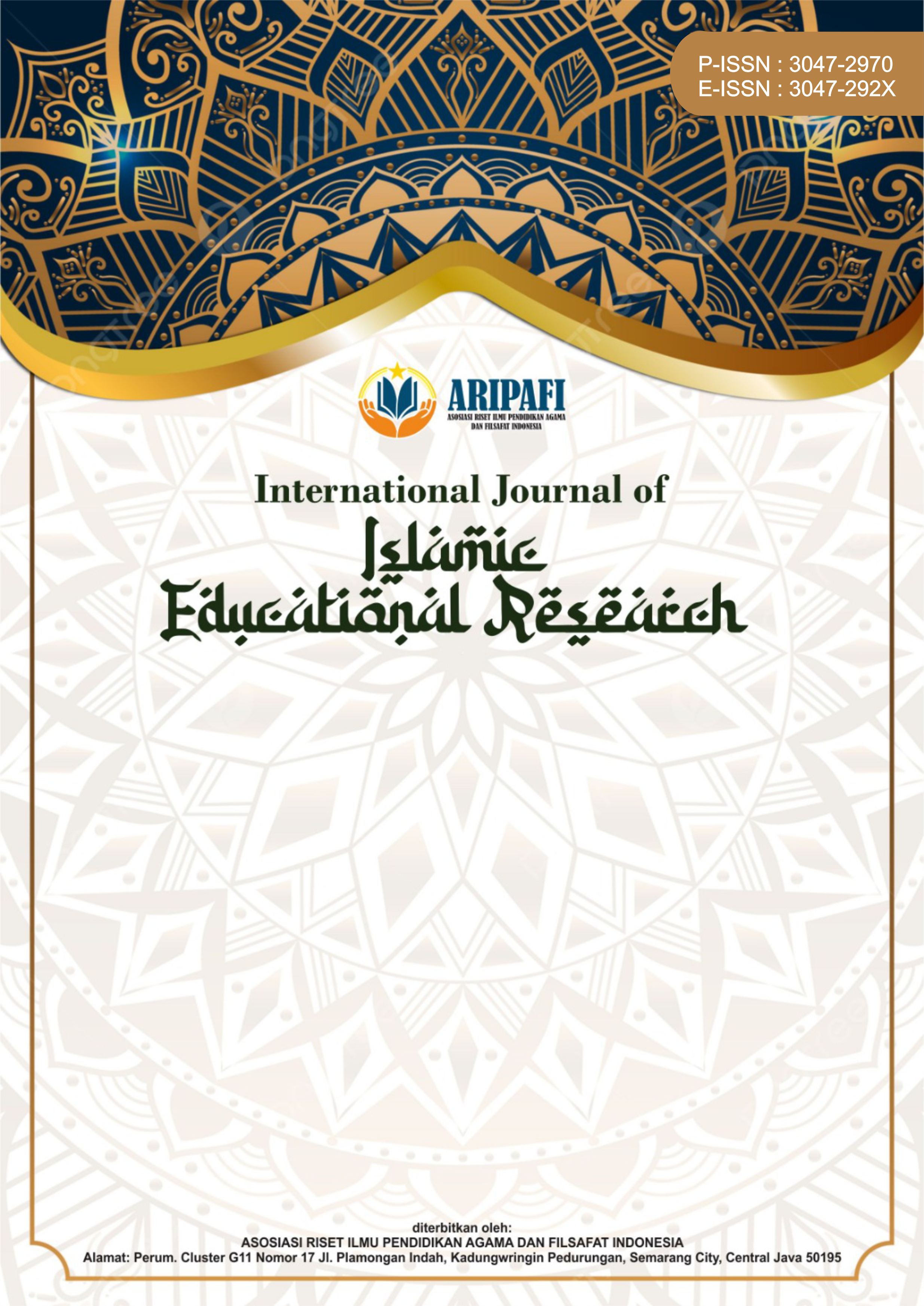Hadith Review of the Phenomenon of Catcalling in the Public Sphere
DOI:
https://doi.org/10.61132/ijier.v2i2.307Keywords:
Catcalling, Hadith Thematic, Non Verbal, Public Area, VerbalAbstract
Catcalling, also known as street harassment, is a form of sexual harassment that occurs in public places. This form of harassment usually takes the form of unwanted, sexual, provocative or degrading comments or statements, and is often directed at other people, especially women. Many believe that catcalling is something common and normal, some even consider it a compliment or joke that usually occurs in public places. This research adopts a qualitative approach, collecting main data from hadiths contained in digital collections such as Maktabah Syamilah, Hadith Soft, and Hadith Encyclopedia Buku 9 Imams. Secondary data sources include literature related to catcalling cases. Data was collected through library research. This research uses thematic methods to analyze contemporary hadiths and applies grounded theory methods. This research reveals that catcalling has two types, namely verbal and non-verbal. The perpetrator often says words with the aim of teasing. And there are several precautions that we must take to prevent catcalling. These include guarding your words and actions, having the principles of ukhuwwah Islamiyyah, being silent, and not sitting on the side of the road.
References
ʻAbdillāh M. ibn I. ibn I. ibn al-M. al-J. al-Bukhāriy, A. (1422). Al-Jāmiʻ al-Musnad al-Ṣaḥīḥ al-Mukhtaṣar min Umūr Rasūl Allāh Ṣallā Allāh ʻalaih wasallam wa Sunanih wa Ayyāmih (Vols. 1–9). Dār Ṭauq al-Najāt. https://shamela.ws/book/1681
Abū Dāwud, S. ibn al-A. ibn I. ibn B. ibn S. ibn ʻAmru al-A. al-S. (2009). Sunan Abī Dāwud (Vols. 1–7). Dār al-Risālah al-ʻĀlamiyah. https://shamela.ws/book/117359
Anjani Yudha, D., & Mulyadi Nugraha, D. (2021). Dampak dan peran hukum fenomena catcalling di Indonesia. Dinamika Sosial Budaya, 23(2), 324–332. http://journals.usm.ac.id/index.php/jdsb
Arif, A. M. (2023). Persepsi mahasiswa terhadap catcalling [Skripsi, Universitas Lampung].
Avezahra, M. H., Kamila, A. A. N., Maulana, N. A., Kravvariti, V., Sa’id, M., & Noorrizki, R. D. (2023). Catcalling victims’ long-term psychological impacts: A qualitative study. Psikohumaniora, 8(2), 329–348. https://doi.org/10.21580/pjpp.v8i2.18287
Ayu, I. G., & Budiasih, N. (2013). Metode Grounded Theory dalam riset kualitatif. Jurnal Ilmiah Akuntansi dan Bisnis, 9(1), 19–27.
Breckenridge, J., & Jones, D. (2009). The grounded theory review. Boletim Técnico, 8(2), 1–126. http://www.sxf.uevora.pt/wp-content/uploads/2013/03/Glaser_1967.pdf
Daud, I. I., Puluhulawa, M. R. U., & Towadi, M. (2022). Verbal sexual harassment victim (catcalling) legal protection in human rights perspective in Indonesia. Estudios de Law Journal, 4(2), 679–694. https://doi.org/10.33756/eslaj.v4i2.16245
Dm, M. Y., Nofarizal, D., Putr, F., Hutagaol, H. D., & Krisna, T. (2024). Protection of victims of human rights violations. Awang Long Law Review, 6(2), 533–542. https://ejournal.stih-awanglong.ac.id/index.php/awl/article/download/1256/755/
Duyvendak, J. W., & Lemieux, C. (2021). Politicizing street harassment: The constitution of a public problem in the Netherlands and France. Amsterdam.
Glaser, B. G., & Anselm, L. S. (2015). The discovery of grounded theory: Strategies for qualitative research. London. http://www.sxf.uevora.pt/wp-content/uploads/2013/03/Glaser_1967.pdf
Hanifah, W., & Atiqurrahman, M. (2023). Catcalling dan representasi pelecehan verbal-seksis dalam Dear David: Pendekatan semiotika John Fiske. Pena Literasi: Jurnal Pendidikan Bahasa dan Sastra Indonesia, 132–140.
Hidayat, A., & Setyanto, Y. (2020). Fenomena catcalling sebagai bentuk pelecehan seksual secara verbal terhadap perempuan di Jakarta. Koneksi, 3(2), 485. https://doi.org/10.24912/kn.v3i2.6487
Ibn al-Ḥajjāj, M. (1955). Al-Musnad al-Ṣaḥīḥ al-Mukhtaṣar bi Naql al-ʻAdl ʻan al-ʻAdl ilā Rasūl Allāh Ṣallā Allāh ʻalaih wasallam (Vols. 1–5). Dār Iḥyā’ al-Turāṡ al-ʻArabiy. https://shamela.ws/book/1727
Ibn Ḥanbal, A. (1995). Musnad al-Imām Aḥmad ibn Ḥanbal (Vols. 1–20). Dār al-Ḥadīṡ. https://shamela.ws/book/98139
Irbah, V. R. (2023). Dampak negatif cat calling terhadap psikologi siswa dan langkah antisipatifnya di MAN 4 Sleman Yogyakarta.
ʻĪsā, A. M. ibn ʻĪsā ibn S. ibn M. al-Ḍaḥḥāk al-Tirmiżiy, A. (1996). Al-Jāmiʻ al-Kabīr (Sunan al-Tirmiżiy) (Vols. 1–6). Dār al-Garb al-Islāmiy. https://shamela.ws/book/7895
Khumairok, M., & Soekorini, N. (2021). Catcalling sebagai perilaku pelecehan seksual secara verbal. ENES Law Review, 7(2), 114–127. https://doi.org/10.31933/unesrev.v7i1
Liyani, W., & Hanum, F. (2019). Street harassment: Catcalling sebagai salah satu bentuk pelecehan seksual terhadap perempuan di Yogyakarta. Jurnal Pendidikan Sosiologi, 2–27. https://journal.student.uny.ac.id/index.php/societas/article/download/17117/16526
Mufakkar, S., & Antasari, R. R. (2023). Penyelesaian kasus catcalling menggunakan cara restorative justice perspektif asas kepastian, keadilan dan kemanfaatan hukum serta hukum Islam. Intizar, 29(2), 152–158. https://doi.org/10.19109/intizar.v29i2.20375
Nugraha, A., & Zuhriah, Z. (2023). Interaksi sosial catcalling terhadap perempuan berpenampilan syar’i di Kota Medan. Satwika: Kajian Ilmu Budaya dan Perubahan Sosial, 7(1), 276–284. https://doi.org/10.22219/satwika.v7i1.25781
Prasmadena, E., Pitaloka, T. R., & Putri, A. K. (2021). Pemaknaan kekerasan simbolik dalam pelecehan seksual secara verbal (catcalling). Journal of Development and Social Change, 4(1), 90–114. https://jurnal.uns.ac.id/jodasc/article/view/52498
Qila, Z., Saffana, N., Rahmadina, N., Rizki, R., & Azizah, F. (2021). Catcalling sebagai bentuk pelecehan seksual traumatis. Jurnal Mahasiswa Komunikasi Cantrik, 1(2), 95–106.
Tauratiya, T. (2020). Perbuatan catcalling dalam perspektif hukum positif. Ekspose: Jurnal Penelitian Hukum dan Pendidikan, 19(1), 1019–1025. https://doi.org/10.30863/ekspose.v1i1.690
Yudha, D. A., & Nugraha, D. M. (2021). Dampak dan peran hukum fenomena catcalling di Indonesia. Dinamika Sosial Budaya, 23(2), 324–332. http://journals.usm.ac.id/index.php/jdsb
Downloads
Published
How to Cite
Issue
Section
License
Copyright (c) 2025 International Journal of Islamic Educational Research

This work is licensed under a Creative Commons Attribution-ShareAlike 4.0 International License.





